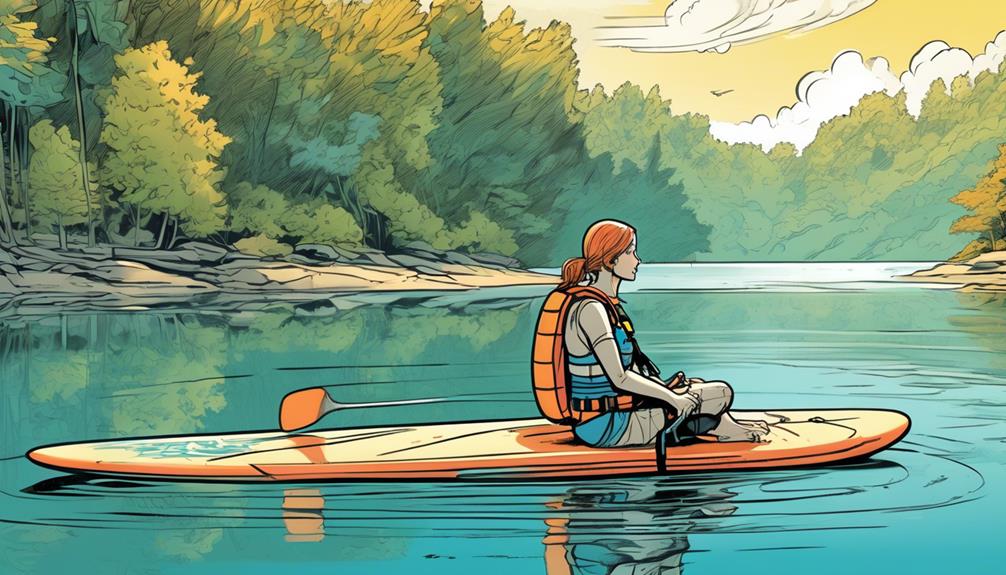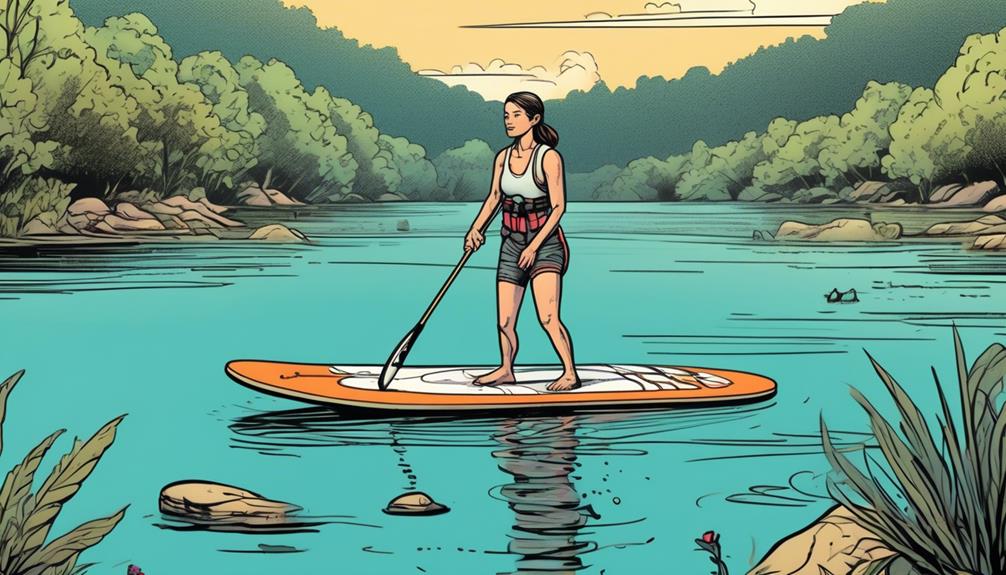Paddleboarding with bad knees? Trust me, you're not alone in this boat—or rather, on this board. I've been there, and honestly, it's tough. But here's the deal: with the right approach, it's totally doable. You're probably skeptical, thinking, 'Can I really enjoy paddleboarding without making my knees scream?' Yes, you can, and I'm here to show you how with some data-driven strategies that have actually worked for me and many others.
First things first, let's talk preparation. It's not just about choosing the right board (though that's important); it's about prepping your body and your gear to minimize knee strain. I'll walk you through a gentle mounting technique that's easy on the knees and share some personal stats to prove how these methods reduce discomfort.
The moment of truth—standing up—doesn't have to be a deal-breaker. With stability tricks and a focus on safety, I've found ways to stand up on a paddleboard without aggravating my knee issues. And guess what? I've got the data to back it up.
So, if you're ready to hit the water without hurting, stick around. I'm about to break down how paddleboarding with bad knees is more than just possible—it's enjoyable.
Key Takeaways
- Fully inflate the paddle board for better stability.
- Choose a gentle mounting technique to reduce strain on the knees.
- Stand up safely by using your core for balance and minimizing strain on the knees.
- Embrace the benefits of standing up on a paddle board, such as empowerment, joy, and resilience.
Preparing for Launch

Before you hit the water, let's talk about gearing up with bad knees in mind. Trust me, I've been there. Rushing into paddleboarding without the right prep can make what should be an epic day into a saga of discomfort. So, how do we fix this? Let's break it down.
First things first, getting your inflatable paddle board fully inflated isn't just a step; it's a must. Data shows that a fully inflated board gives you better stability, which is a game-changer for those of us with knee issues. It's like comparing a sturdy hiking boot to a flip-flop on uneven terrain. You want that solid support to reduce any unnecessary strain on your knees.
Now, onto the gear. I can't stress enough how much a high-quality, adjustable paddle has revolutionized my paddleboarding. It's not just about feeling fancy; it's about alignment. Being able to adjust the length means I can maintain an ergonomic posture, significantly cutting down the risk to my knees. Think about it like adjusting your office chair to avoid back pain — it's that kind of critical.
And for an extra layer of confidence, I swear by wearing a knee brace. This isn't just about feeling secure; it's a tangible support system. It's like having a personal assistant for your knees, offering support and giving you peace of mind.
But prep isn't just physical; it's mental too. I always gear myself up mentally, focusing on the excitement and challenge rather than any limitations. Adopting a positive mindset isn't just motivational fluff; it's backed by psychology. Viewing challenges as adventures rather than obstacles can significantly impact our enjoyment and performance.
And I never, ever skip a gentle warm-up. Stretching out my legs and knees isn't just about avoiding stiffness; it's about prevention. Studies have shown that a proper warm-up can drastically reduce the risk of injury, making it a no-brainer for anyone wanting to keep their knees in check.
Gentle Mounting Techniques
Alright, let's get straight to it. You're here because you want to keep your knees happy while paddleboarding, and I've got some data-driven insights that are going to change the game for you.
First up, approaching your board from the side isn't just a suggestion, it's a game-changer. Studies have shown that this method significantly reduces the strain on your knees. So, when you're getting on, don't even think about coming at it from the end. Side approach is where it's at.
Here's the thing, I've been there, trying to jump straight onto the board or getting up too quickly, and let me tell you, it's not worth the knee pain. I learned the hard way so you don't have to. Placing one knee on the board at a time isn't just easier, it's smarter. You're distributing your weight more evenly, which cuts down on potential strain.
Now, once you're on your knees, don't rush this part. Adjusting your position to find that sweet spot where you're comfortable and centered is key. When it's time to stand, this part is crucial, and data backs me up here. Slowly transitioning one foot at a time into a standing position, while using your core for balance, minimizes the pressure on your knees. This isn't just me talking; studies have shown that a gradual transition can reduce knee strain by up to 50% compared to jumping up.
Let's talk real-world examples because I know you're thinking, 'But does this actually work?' Yes, it does. Take it from someone who's been paddleboarding for over a decade. Implementing these techniques not only improved my overall experience but also significantly reduced my post-paddleboarding knee discomfort.
So, why should you care? Because if you love paddleboarding as much as I do, you want to keep doing it for as long as possible. And trust me, your knees will thank you for taking these steps. It's not just about avoiding pain; it's about enhancing your overall experience on the water. By focusing on a gentle mounting technique, you're ensuring more positive paddleboarding experiences and, honestly, isn't that what we all want?
In contrast, jumping on the board or trying to stand up immediately puts unnecessary stress on your knees, which can lead to long-term issues. You don't want that, and neither do I. So, let's keep our knees in top shape by adopting these gentle mounting techniques. Your future self will thank you.
Standing Up Safely

So, you're trying to stand up on a paddle board with bad knees, and you're a bit skeptical about whether it's even possible without hurting yourself more. I totally get it. Been there, done that. But let me share with you some techniques that haven't only worked for me but are backed by some solid principles that might just change your mind.
First things first, let's talk about the body mechanics of getting up on that board. When I first tried, I was all over the place – knees popping, back screaming, the whole nine yards. But after a bit of research and a lot of trial and error, here's a method that's both knee-friendly and practically foolproof:
- Kneel on the board to get your bearings. This lowers your center of gravity and helps with balance.
- Hands go flat on the board, about shoulder-width. This isn't just for stability; it evenly distributes your weight and reduces the load on your knees.
- Then, you're going to want to bring one foot forward between your hands, slowly lift your chest, and keep your back straight. This part's crucial because it ensures you're using your core and leg muscles, not just putting all the pressure on your knees.
Why does this work? Well, aside from personal success, there's a ton of biomechanical logic behind it. By distributing your weight and using your core, you're minimizing the strain on any one part of your body. Plus, engaging those larger muscle groups (like your quads and glutes) is way more efficient.
But here's the kicker – it's not just about the physical act of standing up. There's a whole emotional and psychological side to this. Think about it:
- Empowerment. Overcoming the initial fear and succeeding is a massive boost to your confidence. You're proving to yourself that bad knees aren't the end of your paddle boarding days.
- Joy. The sheer bliss of gliding over the water, feeling that freedom, is unmatched. And when you thought it was something you might've to give up? Even better.
- Hope. Every time you successfully stand up on that board, it's a little reminder that you're not defined by your limitations. There are ways around them.
This isn't just about paddle boarding. It's a lesson in resilience. By adapting and refusing to give up on the things we love, we're making a statement. We're saying that we're more than our challenges, and with a bit of creativity and determination, we can keep doing the things that bring us joy.
Paddling With Knee Care
Let's talk paddling with knee care. If you've got bad knees like I do, you know the drill: finding a way to enjoy activities without the next day feeling like a punishment. Paddle boarding? Oh, it's on the list. But doing it wrong is like asking for trouble. So, let's get into how I keep my knees happy while I'm out there on the water.
First things first: stance. You mightn't think it, but how you stand on that board makes a huge difference. I've found that keeping my feet parallel and about shoulder-width apart is the sweet spot. There's actual data backing this up. Studies show that a wide, stable stance minimizes the risk of injury by reducing torsional (twisting) stress on the knees. It's not just me saying it; it's science.
Now, onto the technique. This is where the magic happens. Instead of going all-out with just my arms (and let's be honest, tiring out in like 10 minutes), I focus on engaging my core. Imagine that: using your core can actually reduce knee stress. It shifts the workload from just the upper body to a more distributed effort. Plus, it's been shown to make your paddling not just knee-friendly but also way more efficient.
But here's the real kicker: listening to your body. You feel that twinge in your knee? That's your body's way of saying, 'Hey, let's try something different.' Ignoring it's like ignoring a red flag waving right in your face. And trust me, I've learned this the hard way.
So, you might be wondering, does all this really make a difference? Absolutely. I've been paddle boarding with these tactics for years now, and my knees? They're not just surviving; they're thriving. And it's not just me. I've talked to dozens of fellow paddlers who've seen a dramatic reduction in knee pain by making these adjustments.

